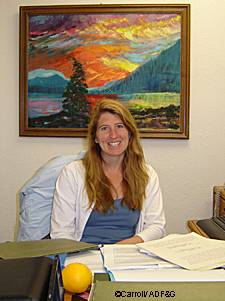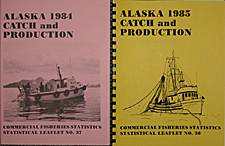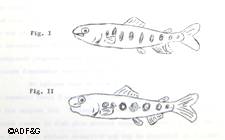Alaska Fish & Wildlife News
June 2006
From the File Cabinet to the Web
ADF&G Publications Soon to be Available On-line

A request for a 1955 crab leaflet was one of the first items to land in my brand new state e-mail account in 2001. I was sure they meant 1995, but I was mistaken. I called someone who told me to call someone else who transferred me and I eventually found this leaflet in Kodiak or somewhere.
At the Alaska Department of Fish and Game (ADF&G), Division of Commercial Fisheries, thousands of old publications — some published before statehood — currently reside in seldom-opened file cabinets all over the state. A glance through one of these file cabinets is a visual nostalgia trip back through the decades: quirky typewriter fonts, hand-drawn cover illustrations, and pages numbered in ball point pen are a quaint reminder of life before computers.
Currently, Commercial Fisheries publications back to 2004 are available online, and Sport Fish publications are available back to 1987. See the end of the story for the web addresses. Older publications are listed online by series, title, author and year and can be requested by emailing me. I will then track down the report and send it to you in your choice of format: pdf, hard copy, or fax. There is no typical request; old reports are requested just as often as more recent ones.
This is now slated to change, however — a text-searchable statewide database of all commercial fisheries publications is now a top priority. Commercial Fisheries will be integrating their publications into a currently existing Division of Sport Fish publication database, maintained by Research and Technical Services in Anchorage. Geron Bruce, a deputy director in Juneau, is heading this project.
The most time consuming tasks are scanning the publications and channeling them through the optical character recognition (OCR) process. Currently the Division has 3,800 documents scanned as pdf files, most of which are not text-searchable and will have to go through the OCR process. Optical character recognition software turns a static image of type (a scanned page) into actual type — making the publication text-searchable. This saves countless hours that would otherwise be spent retyping older publications for which there is no original electronic copy.

Debbie Hart is coordinating the scanning, OCR, endnote library, and database integration details. The time it takes to send a publication through the OCR process varies widely.
“Some documents just take a minute. The hardest thing is the tables; OCR has trouble reading them," Hart said. "Complicated figures can be really messy and a good OCR can take up to 20 minutes. The non-standard typewriter fonts in the older publications take more time to send through the OCR process; the software sometimes has difficulty recognizing the letters.”
Hart estimates there are at least 700 more publications that need to be scanned, with the possibility of many more. “Reports out there that we know are referenced – that number could be in the thousands,” according to Hart. “For instance, mariculture has a whole bunch of filing cabinets full of publications; some are part of an already established reporting series, some are not. If you think about all the reports connected to commercial fisheries in this way it can really get way outside our scope.”
What other publications to include in the database is also up for debate. Some past report series have not always been peer reviewed, bringing up their suitability for placing in the public domain and for citation. Currently only citable publications are included in the sport fish database. Regional Information Reports (RIR), which ran from 1987 to 2004, were not required to undergo peer review, and have a disclaimer against citation without approval from the authors; despite this, this series has been cited extensively.
“The level of review varies so widely; some of the RIRs have been heavily reviewed.” Hart said. She has not yet hit upon an ideal solution. “One option is to just take away the author approval language from the existing disclaimer. Another is to come up with a new disclaimer that better reflects the history and intent of the RIR series and provides citation approval. This has not yet been decided.”
Bruce wants to include as many RIRs as possible. “As long as they have had in-house peer review they should be candidates for inclusion in the database. The ones that haven’t had any kind of review — gray literature — may be only available to staff,” he said.
Also connected to this database is an endnote library. “It is a ‘cite as you write’ process linked to MS Word that pulls up the cited format and will create a bibliography as I write," Hart said. "It’s a very handy tool for writing reports, and excellent for maintaining consistency. Everyone is using the same database and thus the same format.”

Bruce currently plans to hire high school juniors or seniors for summer jobs in some area offices. Part of their duties would be to scan and OCR documents that are located in the area offices. “This is a great combination of the Youth Initiative Program plus our publications project," he said. "People under the age of 18 are limited in the kinds of work they can perform, for example working in the field camps, so we need to develop a set of tasks that could be appropriately performed by these younger workers, and at the same time expose them to working in an area office for the Division of Commercial Fisheries.”
Currently there are no plans to incorporate other ADF&G divisions' publications into this database, although the door is open. “There aren’t any plans with other divisions; although I think it’s worth exploring whether to bring some of the Division of Subsistence’s fishing publications into it.” Bruce said.
Hart is in the midst of organizing the whole project with Research and Technical Services in Anchorage, and is working on ideas to get a more consistent tone with divisional publications. “We need to increase standardization. The whole concept of consistency has value. A standard procedure across the division, and perhaps divisions, will better accommodate how we report on our efforts and keep the public informed on their natural resources," she said. “It all boils down to having a comprehensive data and document management system.”
For more information, see: http://www.adfg.alaska.gov/index.cfm?adfg=process.main
Subscribe to be notified about new issues
Receive a monthly notice about new issues and articles.
